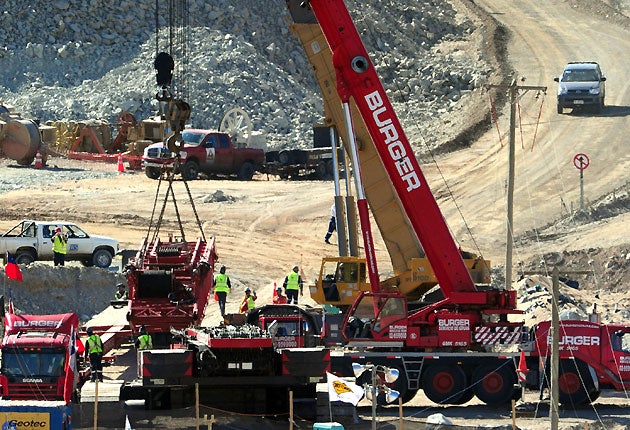The tunnel that rescue workers hope will transport 33 trapped Chilean miners to safety is due to be completed some time before dawn tomorrow, meaning the men could begin returning to the surface as early as Monday morning, the country’s mining minister has announced.
Laurence Goldborne told reporters that the drill cutting their 26 inch-wide escape hole is just 100 metres from the cavern where the men have been living since 5 August, when a rock-fall blocked exit routes from the San Jose gold and copper mine near the north-western city of Copiapo.
Once the tunnel is complete, officials will meet to decide how much, if any, of it ought to be lined with a reinforced steel piping that would prevent any structural damage occurring during the long operation that will eventually see the men lifted to safety, one-by-one, in a steel escape capsule.
The San Jose mine is in an earthquake zone some 450 miles north of Santiago, and not all of the rock that the “Plan B” escape shaft has been drilled through is particularly stable. Any earth tremor or other minor disturbance at the wrong time could endanger the lives of men travelling towards the surface.
Mr Goldborne said he is anxious to avoid any accident that would turn the final stages of what has so far been an extraordinarily well-managed rescue effort into a tragedy. A steel lining would dramatically reduce the chances of such an event.
However encasing the entire tunnel would take roughly ten days, further adding to the ordeal of the men who have already been trapped roughly half a mile underground for more than two months, which is more than twice as long as any other human beings who have been stuck underground.
An alternative being considered by Mr Goldborne, which is thought at present to be the most likely option, would see the first 100 metres of the tunnel, which goes through the most geologically-unstable section rock, protected. That would take two days, meaning the rescue would commence in earnest on Monday.
Going ahead without any lining on the rescue tunnel is also a mooted option, though many would see that as an unnecessary risk. “They are all possible alternatives,” Mr Golborne said. “There are risks and benefits we have to think about.”
Once things get underway in earnest, each of the men will be strapped into the rescue capsule in an upright position for the estimated 15-minute journey to the surface. They will wear an oxygen mask, a belt monitoring their vital signs, and a pair of dark glasses to protect their eyes, which could be damaged by exposure to the desert sunlight.
They miners be met at the surface by a medical team, who will first assess their physical condition before walking them to a field hospital where they have each nominated two close family members to be reunited with them. After that, the men will be airlifted to a hospital in Copiapo, the nearest major town, where they will be detained for at least 24 hours.
There is already a huge international media presence in the region, and as many as 3,000 journalists are expected to descend on the mine and surrounding towns over the weekend. To help them cope with the attention, the miners have been receiving media training during what they hope will be the final few days of their captivity.

Join our commenting forum
Join thought-provoking conversations, follow other Independent readers and see their replies
Comments